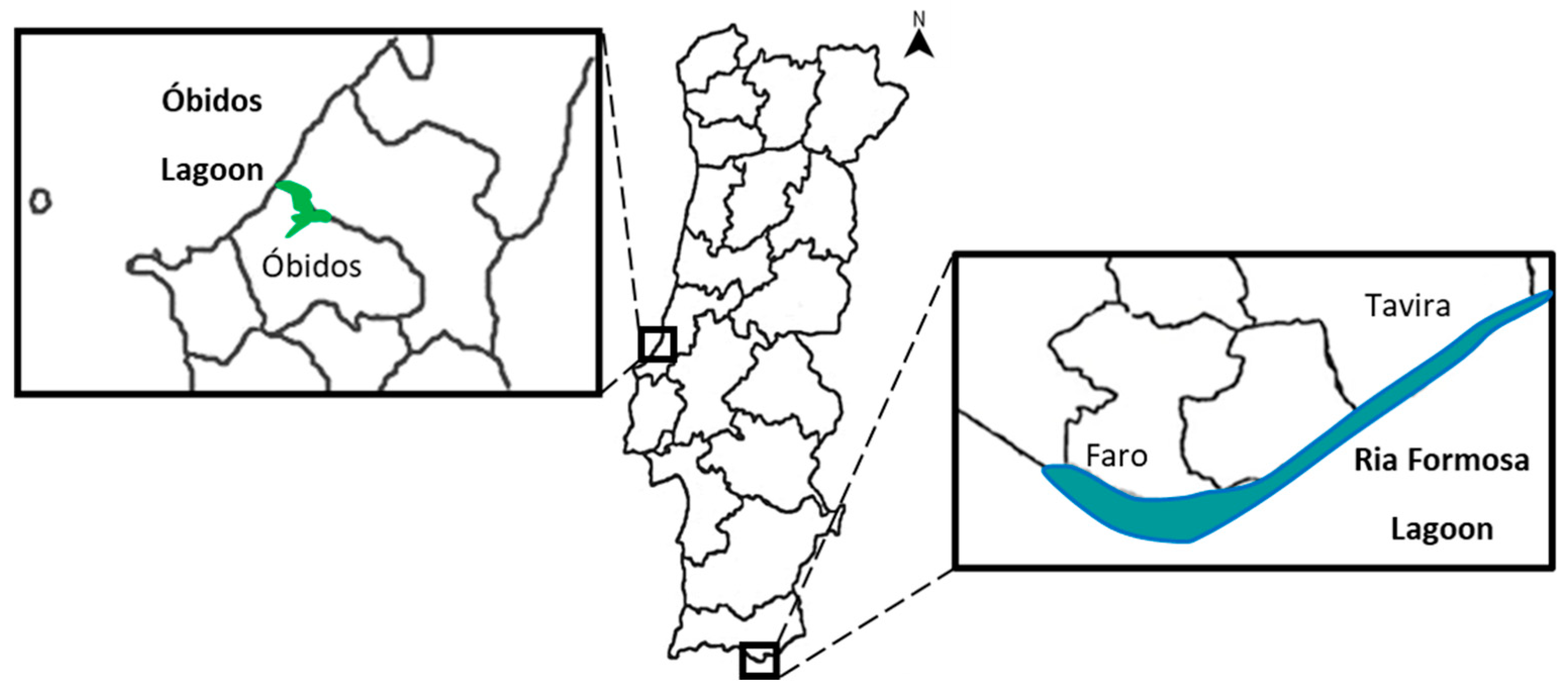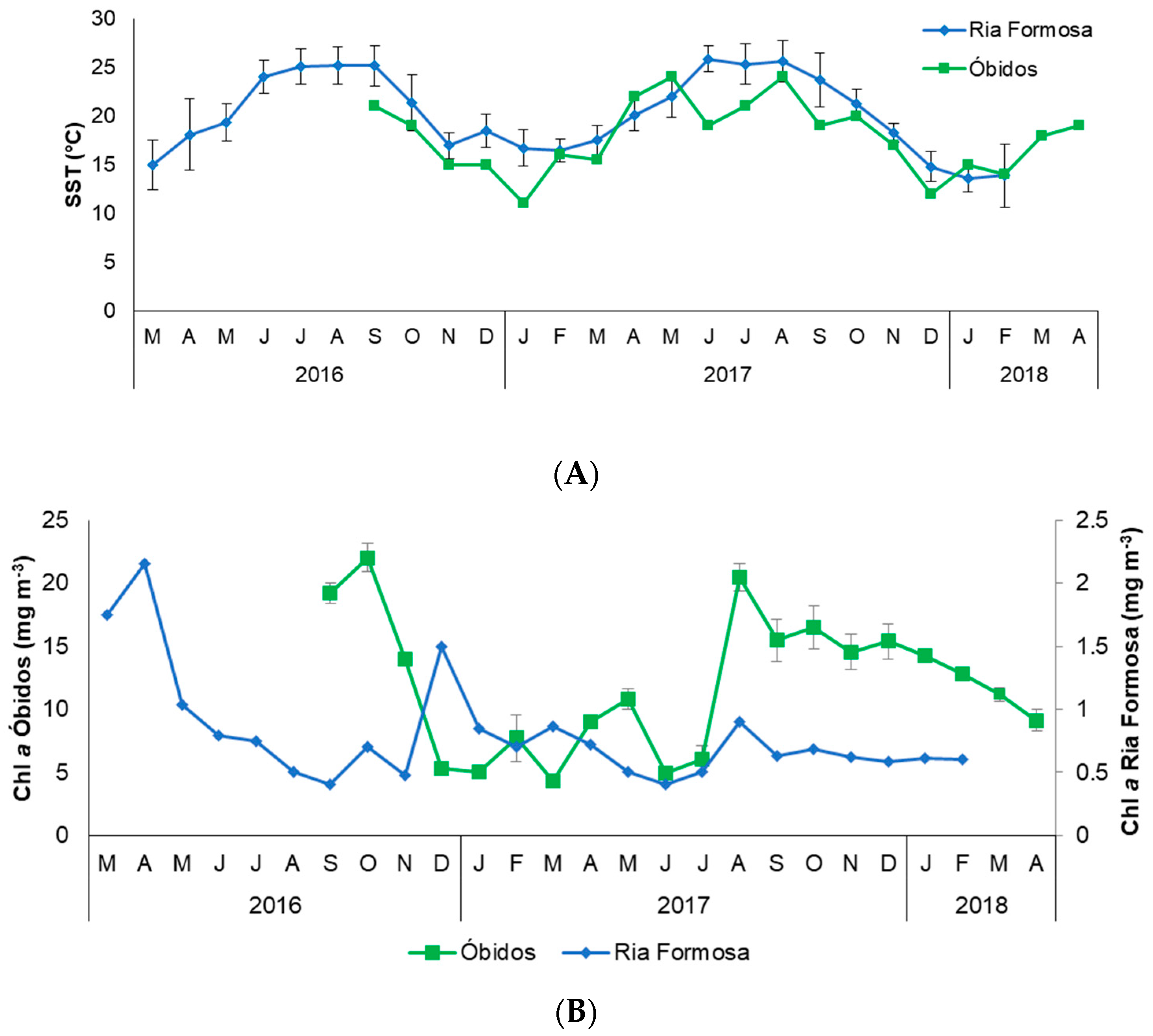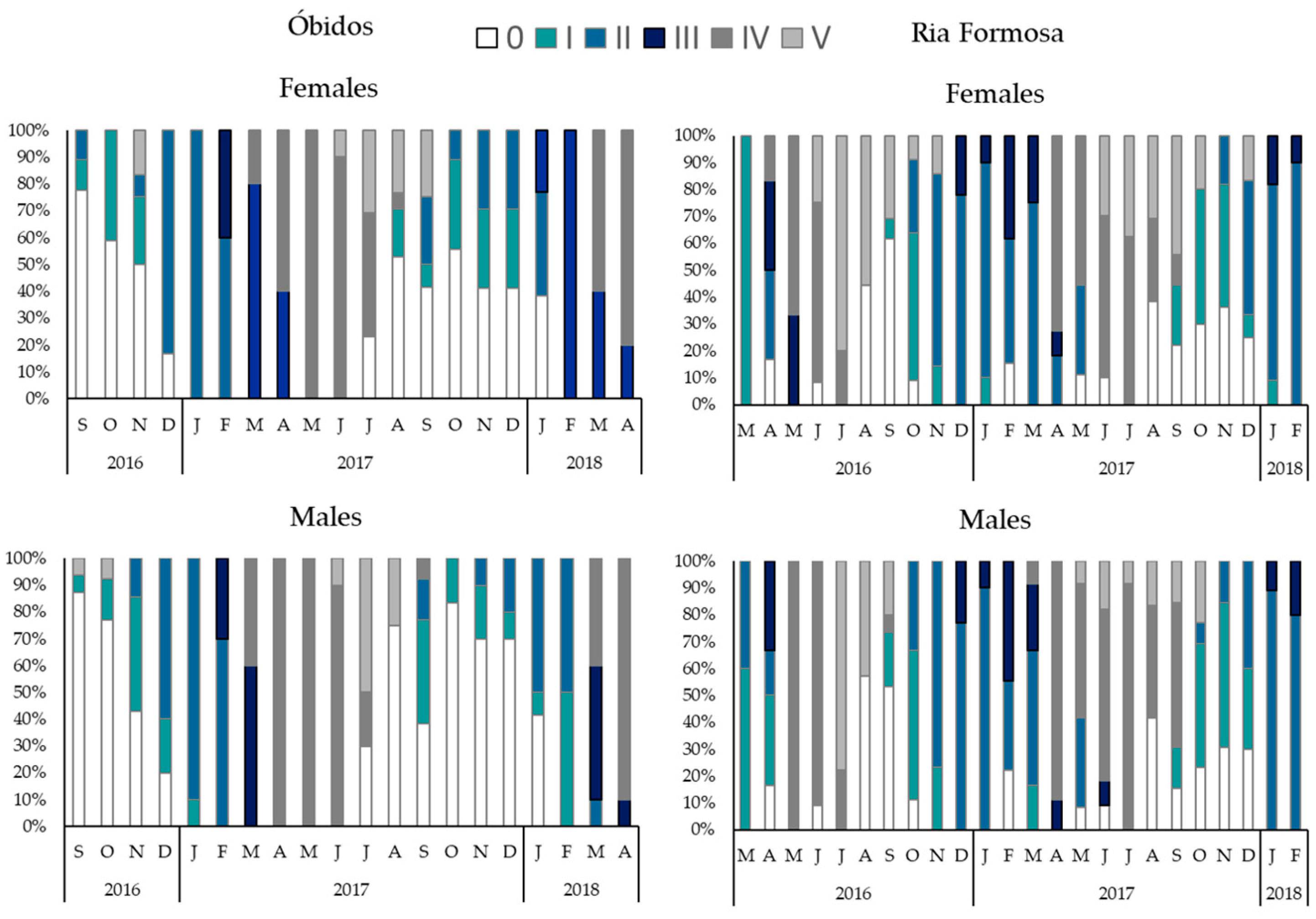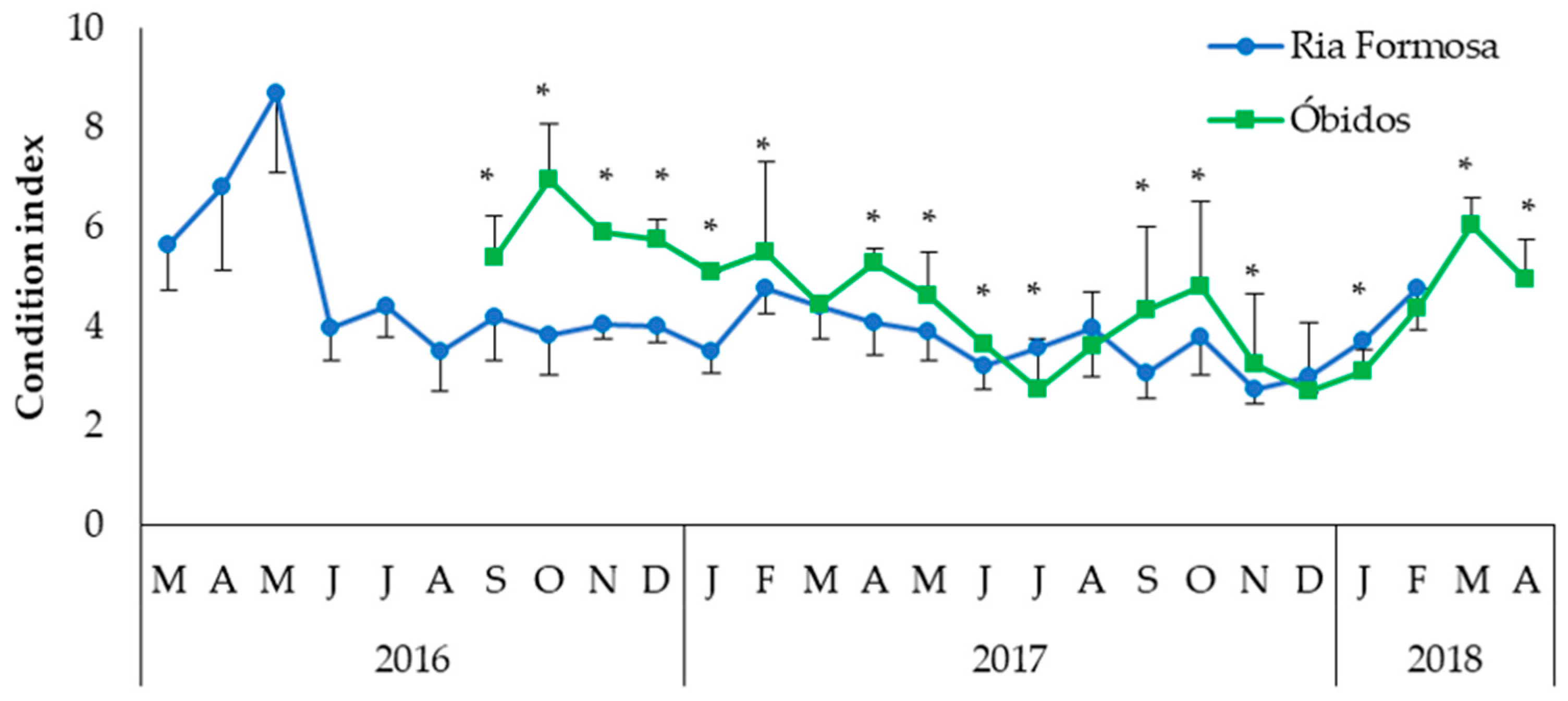Dynamics of the Reproductive Cycle of Two Cerastoderma edule Populations (Óbidos and Ria Formosa Lagoons) along with Their Nutrient Storage and Utilization Strategy
Abstract
1. Introduction
2. Materials and Methods
2.1. Study Sites and Samples Collection
2.2. Water Analysis
2.3. Bivalves Analyses
2.3.1. Histology
2.3.2. Condition Index
2.3.3. Biochemical Analyses
2.4. Statistical Analyses
3. Results
3.1. Sea Surface Temperature and Chlorophyll a
3.2. Gametogenic Cycle
3.3. Condition Index (CI)
3.4. Biochemical Composition
3.5. Principal Component Analysis
4. Discussion
5. Conclusions
Author Contributions
Funding
Institutional Review Board Statement
Data Availability Statement
Acknowledgments
Conflicts of Interest
References
- Hayward, P.J.; Ryland, J.S. Handbook of the Marine Fauna of North-West Europe; Hayward, P.J., Ryland, J.S., Eds.; Oxford University Press: Oxford, UK, 2017. [Google Scholar] [CrossRef]
- Honkoop, P.J.; van der Meer, J. Experimentally induced effects of water temperature and immersion time on reproductive output of bivalves in the Wadden Sea. J. Exp. Mar. Biol. Ecol. 1998, 220, 227–246. [Google Scholar] [CrossRef]
- Burdon, D.; Callaway, R.; Elliott, M.; Smith, T.; Wither, A. Mass mortalities in bivalve populations: A review of the edible cockle Cerastoderma edule (L.). Estuar. Coast. Shelf Sci. 2014, 150, 271–280. [Google Scholar] [CrossRef]
- Malham, S.K.; Hutchinson, T.H.; Longshaw, M. A review of the biology of European cockles (Cerastoderma spp.). J. Mar. Biol. Assoc. UK 2012, 92, 1563–1577. [Google Scholar] [CrossRef]
- Cardoso, J.F.M.F.; Witte, J.I.; van der Veer, H.W. Differential reproductive strategies of two bivalves in the Dutch Wadden Sea. Estuar. Coast. Shelf Sci. 2009, 84, 37–44. [Google Scholar] [CrossRef]
- Enríquez-Díaz, M.; Pouvreau, S.; Chávez-Villalba, J.; Le Pennec, M. Gametogenesis, reproductive investment, and spawning behavior of the Pacific giant oyster Crassostrea gigas: Evidence of an environment-dependent strategy. Aquacult. Int. 2009, 17, 491–506. [Google Scholar] [CrossRef]
- Martínez-Castro, C.; Vázquez, E. Reproductive Cycle of the Cockle Cerastoderma edule (Linnaeus 1758) in the Ría De Vigo (Galicia, Northwest Spain). J. Shellfish. Res. 2012, 31, 757–767. [Google Scholar] [CrossRef]
- Normand, J.; Le Pennec, M.; Boudry, P. Comparative histological study of gametogenesis in diploid and triploid Pacific oysters (Crassostrea gigas) reared in an estuarine farming site in France during the 2003 heatwave. Aquaculture 2008, 282, 124–129. [Google Scholar] [CrossRef]
- Guillou, J.; Bachelet, G.; Glémarec, M. Influence des fluctuations de température sur la reproduction et le recrutement de la coque Cerastoderma edule (L.). Ann. I. Océanogr. 1992, 68, 65–74. Available online: http://archimer.ifremer.fr/doc/1991/acte-1719.pdf (accessed on 20 May 2022).
- Fernández-Castro, N.; Vido-de-Mattio, N. Biochemical composition, condition index, and energy value of Ostrea puelchana (d’Orbigny): Relationships with reproductive cycle. J. Exp. Mar. Biol. Ecol. 1987, 108, 113–126. [Google Scholar] [CrossRef]
- Joaquim, S.; Matias, D.; Ramos, M.; Moura, P.; Arnold, W.; Chícharo, L.; Gaspar, M.B. Reproductive activity and biochemical composition of the pullet carpet shell Venerupis senegalensis (Gremlin, 1791) from Ria de Aveiro (northwestern coast of Portugal). Sci. Mar. 2011, 75, 217–226. [Google Scholar] [CrossRef]
- Ojea, J.; Pazos, A.J.; Martínez, D.; Novoa, S.; Sánchez, J.L.; Abad, M. Seasonal variation in weight and biochemical composition of the tissues of Ruditapes decussatus in relation to the gametogenic cycle. Aquaculture 2004, 238, 451–468. [Google Scholar] [CrossRef]
- Pérez Camacho, A.; Delgado, M.; Fernández-Reiriz, M.J.; Labarta, U. Energy balance, gonad development and biochemical composition in the clam Ruditapes decussatus. Mar. Ecol. Prog. Ser. 2003, 258, 133–145. [Google Scholar] [CrossRef]
- Machado, D.; Baptista, T.; Joaquim, S.; Anjos, C.; Mendes, S.; Matias, A.M.; Matias, D. Reproductive cycle of the European clam Ruditapes decussatus from Óbidos Lagoon, Leiria, Portugal. Invertebr. Reprod. Dev. 2018, 62, 179–190. [Google Scholar] [CrossRef]
- Tlili, S.; Métais, I.; Ayache, N.; Boussetta, H.; Mouneyrac, C. Is the reproduction of Donax trunculus affected by their sites of origin contrasted by their level of contamination? Chemosphere 2012, 84, 1362–1370. [Google Scholar] [CrossRef] [PubMed]
- Joaquim, S.; Matias, D.; Matias, A.M.; Moura, P.; Roque, C.; Chícharo, L.; Gaspar, M.B. Biochemical and energy dynamics throughout the reproductive cycle of the striped venus Chamelea gallina (Mollusca, Bivalvia). Invertebr. Reprod. Dev. 2014, 58, 284–293. [Google Scholar] [CrossRef]
- Matias, D.; Joaquim, S.; Ramos, A.; Sobral, P.; Leitão, A. Biochemical compounds’ dynamics during larval development of the carpet-shell clam Ruditapes decussatus (Linnaeus, 1758): Effects of mono-specific diets and starvation. Helgoland Mar. Res. 2011, 65, 369–380. [Google Scholar] [CrossRef]
- Albentosa, M.; Fernández-Reiriz, M.J.; Labarta, U.; Pérez-Camacho, A. Response of two species of clams, Ruditapes decussatus and Venerupis pullastra, to starvation: Physiological and biochemical parameters. Comp. Biochem. Phys. B 2007, 146, 241–249. [Google Scholar] [CrossRef] [PubMed]
- Bayne, B.L. Aspects of Reproduction in Bivalve Molluscs. In Estuarine Processes: Uses, Stresses and Adaptation to the Estuary; Wiley, M., Ed.; Academic Press: New York, NY, USA, 1976; Volume 1, pp. 432–448. [Google Scholar] [CrossRef]
- Joaquim, S.; Matias, D.; Lopes, B.; Arnold, W.S.; Gaspar, M.B. The reproductive cycle of white clam Spisula solida (L.) (Mollusca: Bivalvia): Implications for aquaculture and wild stock management. Aquaculture 2008, 281, 43–48. [Google Scholar] [CrossRef]
- Matias, D.; Joaquim, S.; Matias, A.M.; Moura, P.; Teixeira De Sousa, J.; Sobral, P.; Leitão, A. The reproductive cycle of the European clam Ruditapes decussatus (L. 1758) in two Portuguese populations: Implications for management and aquaculture programs. Aquaculture 2013, 406–407, 52–61. [Google Scholar] [CrossRef]
- Darriba, S.; San Juan, F.; Guerra, A. Energy storage and utilization in relation to the reproductive cycle in the razor clam Ensis arcuatus (Jefferys 1865). ICES J. Mar. Sci. 2005, 62, 886–896. [Google Scholar] [CrossRef]
- Fearman, J.-A.; Bolch, C.; Moltschaniwskyj, N. Energy storage and reproduction in mussels, Mytilus galloprovincialis: The influence of diet quality. J. Shellfish Res. 2009, 28, 305–312. [Google Scholar] [CrossRef]
- Urrutia, M.B.; Ibarrola, I.; Iglesias, J.I.P.; Navarro, E. Energetics of growth and reproduction in a high-tidal population of the clam Ruditapes decussatus from Urdaibai Estuary (Basque Country, N. Spain). J. Sea Res. 1999, 42, 35–48. [Google Scholar] [CrossRef]
- Guillou, J.; Bachelet, G.; Desprez, M.; Ducrotoy, J.-P.; Madani, I.; Rybarczyk, H.; Sauriau, P.-G.; Sylvand, B.; Elkaim, B.; Glémarec, M. Les modatités de la reproduction de la coque (Cerastoderma edule) sur le littoral Français de la Manche et de l’ Atlantique. Aquat. Living Resour. 1990, 3, 29–41. [Google Scholar] [CrossRef]
- Maia, F.; Barroso, C.M.; Gaspar, M.B. Biology of the common cockle Cerastoderma edule (Linnaeus, 1758) in Ria de Aveiro (NW Portugal): Implications for fisheries management. J. Sea Res. 2021, 171, 102024. [Google Scholar] [CrossRef]
- Rygg, B. Studies on Cerastoderma edule (L.) and Cerastoderma glaucum (Poiret). Sarsia 1970, 43, 65–80. [Google Scholar] [CrossRef]
- Pereira, P.; de Pablo, H.; Vale, C.; Franco, V.; Nogueira, M. Spatial and seasonal variation of water quality in an impacted coastal lagoon (Óbidos Lagoon, Portugal). Environ. Monit. Assess. 2009, 153, 281–292. [Google Scholar] [CrossRef]
- Malhadas, M.S.; Leitão, P.C.; Silva, A.; Neves, R. Effect of coastal waves on sea level in Óbidos Lagoon, Portugal. Cont. Shelf Res. 2009, 29, 1240–1250. [Google Scholar] [CrossRef]
- Newton, A.; Mudge, S.M. Temperature and salinity regimes in a shallow, mesotidal lagoon, the Ria Formosa, Portugal. Estuar. Coast. Shelf Sci. 2003, 57, 73–85. [Google Scholar] [CrossRef]
- Falcão, M.; Vale, C. Sediment-water exchanges of ammonium and phosphate in intertidal and subtidal areas of a mesotidal coastal lagoon (Ria Formosa). Hydrobiologia 1998, 373, 193–201. [Google Scholar] [CrossRef]
- Lorenzen, C.J.; Jeffrey, S.W. Determination of chlorophyll in seawater: Report of intercalibration tests. UNESCO Tech. Pap. Mar. Sci. 1980, 35, 1–20. [Google Scholar]
- Lorenzen, C.J. Determination of chlorophyll and phaeopigments: Spectrophotometric equations. Limnol. Oceanogr. 1967, 12, 343–346. [Google Scholar] [CrossRef]
- Gaspar, M.B.; Monteiro, C.C. Reproductive cycles of the razor clam Ensis siliqua and the clam Venus striatula off Vilamoura, southern Portugal. J. Mar. Biol. Assoc. UK 1998, 78, 1247–1258. [Google Scholar] [CrossRef]
- Seed, R. Ecology. In Marine Mussels: Their Ecology and Physiology; Bayne, B.L., Ed.; Cambridge University Press: Cambridge, UK, 1976; pp. 13–65. [Google Scholar] [CrossRef]
- Walne, P.R.; Mann, R. Growth and biochemical composition of Ostrea edulis and Crassostrea gigas. In Proceedings of the 9th European Marine Biology Symposium Oban, Scotland, UK, 2–8 October 1974; Barnes, H., Ed.; pp. 587–607. [Google Scholar] [CrossRef]
- Viles, F.J.; Silverman, L. Determination of starch and cellulose with anthrone. J. Anal. Chem. 1949, 21, 950–953. [Google Scholar] [CrossRef]
- Folch, J.; Less, M.; Stanley, G.H. A simple method for the isolation and purification of total lipids from animal tissues. J. Biol. Chem. 1957, 226, 497–509. [Google Scholar] [CrossRef] [PubMed]
- Marsh, J.B.; Weinstein, D.B. Simple charring method for determination of lipids. J. Lipid Res. 1966, 7, 574–576. [Google Scholar] [CrossRef] [PubMed]
- Zar, J.H. Biostatistical Analysis, 5th ed.; Prentice-Hall/Pearson: Upper Saddle River, NJ, USA, 2010; Volume xii, p. 944. [Google Scholar]
- Navarro, E.; Iglesias, J.I.P.; Larrañaga, A. Interannual variation in the reproductive cycle and biochemical composition of the cockle Cerastoderma edule from Mundaca Estuary (Biscay, North Spain). Mar. Biol. 1989, 101, 503–511. [Google Scholar] [CrossRef]
- Yankson, K. Reproductive cycle of Cerastoderma glaucum (Bruguière) and C. edule (L.) with special reference to the effects of the 1981–82 severe winter. J. Molluscan Stud. 1986, 52, 6–14. [Google Scholar] [CrossRef]
- Falcão, M.; Vale, C. Nutrient Dynamics in a Coastal Lagoon (Ria Formosa, Portugal): The Importance of Exchanges Lagoon Water—Sea Water on the Biologic Productivity. Cienc. Mar. 2003, 29, 425–433. [Google Scholar] [CrossRef]
- Morgan, E.; O’ Riordan, R.M.; Culloty, S.C. Climate change impacts on potential recruitment in an ecosystem engineer. Ecol. Evol. 2013, 3, 581–594. [Google Scholar] [CrossRef] [PubMed]
- Brown, D.; Campos, B.; Hurban, H.-J. Reproductive cycle of the bivalve clams Semele solida (Gray, 1828) (Semelidae) and Gari solida (Gray, 1828) (Psammobiidae) from chile. J. Shellfish Res. 2002, 21, 627–634. [Google Scholar]
- Boyden, C.R. A Comparative Study of the Reproductive Cycles of the Cockles Cerastoderma edule and C. glaucum. J. Mar. Biol. Assoc. UK 1971, 51, 605–622. [Google Scholar] [CrossRef]
- Massapina, C.; Joaquim, S.; Matias, D.; Devauchelle, N. Oocyte and embryo quality in Crassostrea gigas (Portuguese strain) during a spawning period in Algarve South Portugal. Aquat. Living Resour. 1999, 12, 327–333. [Google Scholar] [CrossRef]
- Gribben, P.E. Gametogenic development and spawning of the razor clam, Zenatia acinaces in northeastern New Zealand. N. Z. J. Mar. Freshw. Res. 2005, 39, 1287–1296. [Google Scholar] [CrossRef]
- Iglesias, J.I.P.; Navarro, E. Energetics of growth and reproduction in cockles (Cerastoderma edule): Seasonal and age-dependent variations. Mar. Biol. 1991, 111, 359–368. [Google Scholar] [CrossRef]
- Ke, Q.; Li, Q. Annual dynamics of glycogen, lipids, and proteins during the reproductive cycle of the surf clam Mactra veneriformis from the north coast of Shandong Peninsular, China. Invertebr. Reprod. Dev. 2013, 57, 49–60. [Google Scholar] [CrossRef]
- Robert, R.G.; Trut, G.; Laborde, J.L. Growth, reproduction and gross biochemical composition of the Manila clam Ruditapes philippinarum in the Bay of Arcachon, France. Mar. Biol. 1993, 116, 291–299. [Google Scholar] [CrossRef]
- Honkoop, P.J.; van der Meer, J.; Beukema, J.J.; Kwast, D. Reproductive investment in the intertidal bivalve Macoma balthica. J. Sea Res. 1999, 41, 203–212. [Google Scholar] [CrossRef]
- Leitão, F.M.; Gaspar, M.B. Comparison of the burrowing response of undersized cockles (Cerastoderma edule) after fishing disturbance caused by hand dredge and harvesting knife. Mar. Biol. Res. 2011, 7, 509–514. [Google Scholar] [CrossRef]







Disclaimer/Publisher’s Note: The statements, opinions and data contained in all publications are solely those of the individual author(s) and contributor(s) and not of MDPI and/or the editor(s). MDPI and/or the editor(s) disclaim responsibility for any injury to people or property resulting from any ideas, methods, instructions or products referred to in the content. |
© 2023 by the authors. Licensee MDPI, Basel, Switzerland. This article is an open access article distributed under the terms and conditions of the Creative Commons Attribution (CC BY) license (https://creativecommons.org/licenses/by/4.0/).
Share and Cite
Joaquim, S.; Matias, A.M.; Moura, P.; Trindade, B.; Gaspar, M.B.; Baptista, T.; Matias, D. Dynamics of the Reproductive Cycle of Two Cerastoderma edule Populations (Óbidos and Ria Formosa Lagoons) along with Their Nutrient Storage and Utilization Strategy. Fishes 2023, 8, 353. https://doi.org/10.3390/fishes8070353
Joaquim S, Matias AM, Moura P, Trindade B, Gaspar MB, Baptista T, Matias D. Dynamics of the Reproductive Cycle of Two Cerastoderma edule Populations (Óbidos and Ria Formosa Lagoons) along with Their Nutrient Storage and Utilization Strategy. Fishes. 2023; 8(7):353. https://doi.org/10.3390/fishes8070353
Chicago/Turabian StyleJoaquim, Sandra, Ana Margarete Matias, Paula Moura, Beatriz Trindade, Miguel B. Gaspar, Teresa Baptista, and Domitília Matias. 2023. "Dynamics of the Reproductive Cycle of Two Cerastoderma edule Populations (Óbidos and Ria Formosa Lagoons) along with Their Nutrient Storage and Utilization Strategy" Fishes 8, no. 7: 353. https://doi.org/10.3390/fishes8070353
APA StyleJoaquim, S., Matias, A. M., Moura, P., Trindade, B., Gaspar, M. B., Baptista, T., & Matias, D. (2023). Dynamics of the Reproductive Cycle of Two Cerastoderma edule Populations (Óbidos and Ria Formosa Lagoons) along with Their Nutrient Storage and Utilization Strategy. Fishes, 8(7), 353. https://doi.org/10.3390/fishes8070353






